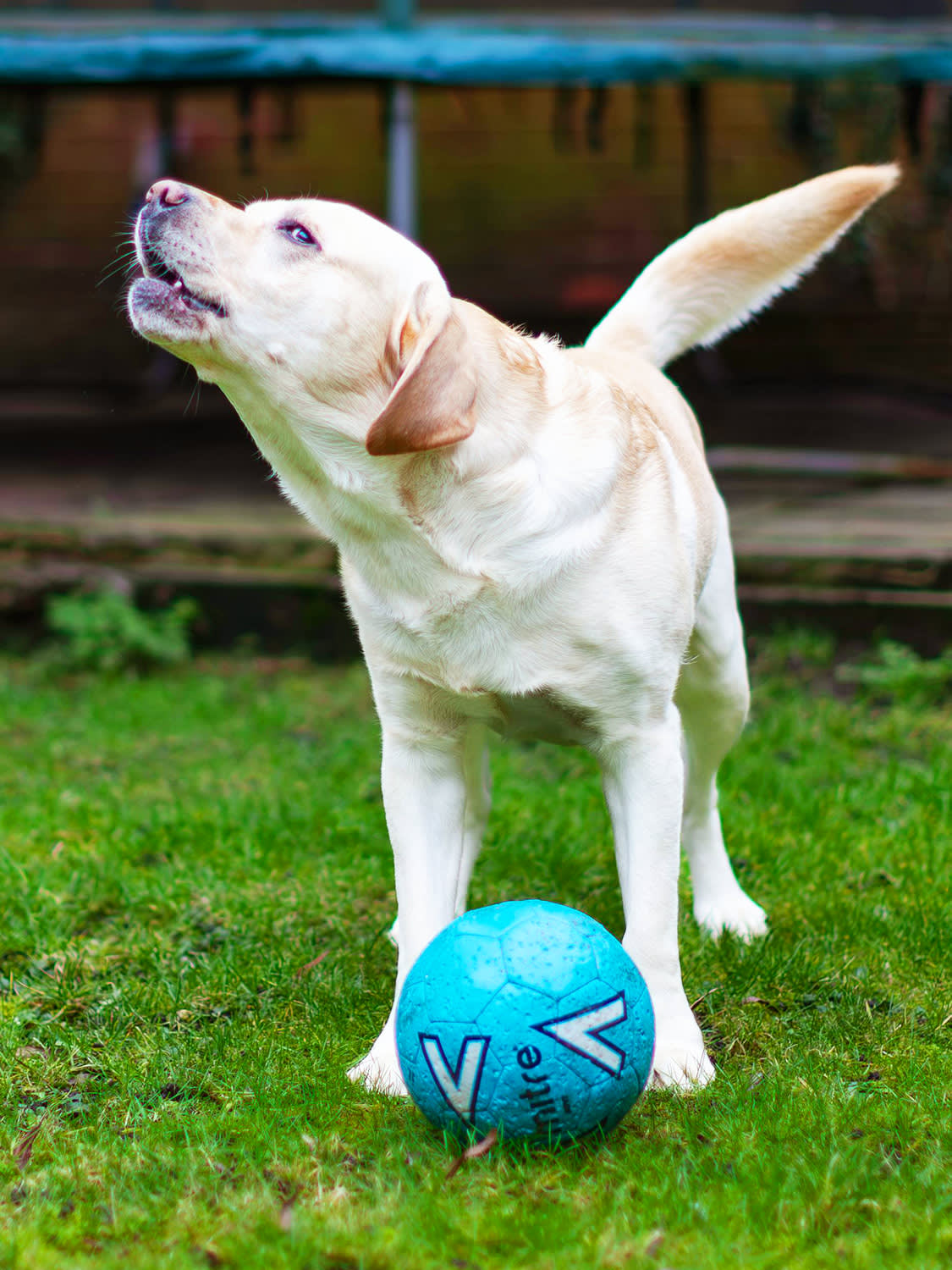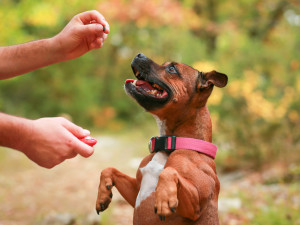Does the ‘Thank You Theory’ Actually Work for Dogs?
Can thanking your dog for barking stop them barking?

Share Article
There’s no doubt about it, as much as we love our dogs, their excessive barking can be annoying, especially when we’re trying to work, or watch Netflix. Does your dog kick off any time someone has the audacity to walk past your window or ring your doorbell? Then you might be interested in the ‘Thank You Theory’.
While sudden barking is both startling and annoying, it’s important to remember that our dogs bark for a reason, as a way of communicating their needs. My dog, Sherlock, will bark his head off any time he deems someone to be standing too close to our gate, and I slowly realised that he was just doing his ‘job’ of trying to protect us. So, instead of being annoyed, I started saying, “Thank you for keeping us safe”.
I later learned that there’s actually a whole training theory based around this, called the ‘Thank You Theory’ or the ‘Thank You for Barking Theory’. Now, it may sound counterintuitive to thank a dog for doing something you hate, but this theory has legs, and is grounded in positive reinforcement and embracing natural dog behaviour.
Curious? Let’s see how it works.
What is the Thank You Theory?
The ‘Thank You’ or ‘Thank You for Barking’ protocol was coined by Chicago-based dog trainer, Kiki Yablonopens in new tab, and was introduced to the masses when she wrote a short blogopens in new tab about it back in 2017. The idea came to her thanks to her dog, Pigeon, who would run and bark at people or dogs that he’d see walking past their garden gate. Unfortunately, this behaviour kept being reinforced because the people/dogs would go away, making Pigeon think his barking was doing a top job of getting rid of the (perceived) threat.
Yablon tried using Pigeon’s usual recall cueopens in new tab (a whistle), which didn’t work, so she began rewarding him with a treat if he so much as glanced at her when she tried to recall him. This helped her realise that the key was to interrupt the behaviour as soon as it started, acknowledging the dog’s alert bark, before redirecting the dog. It also became clear that she needed to use a brand new cue, which is why she decided on, “Thank you”, as it’s likely not one most of us already use. This then turned into a full training protocol, using treats and a clicker.
So often we forget that our dogs have hard-wired natural instincts that have been carried over from their wild days, such as being territorial, rolling in muck and protecting their pack. This method works with their protective instincts, rather than against them, by acknowledging the alert and embracing positive reinforcement, rather than utilising punishment methods (like angrily telling a dog to “Shush”, or shouting at them).
How the Thank You Theory works
This training method is best used at home in situations where your dog barks at external stimuli, such as noises on the street or someone at the door. You’ll need to start training away from these trigger areas, ie, where your dog usually barks, like the window, front door or garden fence. The goal is that your dog will stop barking and come to you when you say, “Thank you”, eventually coming of their own accord (without you needing to use the cue).
“This technique draws on classical (association = ‘I bark → person responds → job done → I can relax’) and operant conditioning (consequence = ‘I bark → person responds → one bark is reinforced and I’m listened to → more barking isn’t reinforced → I learn one bark works; more are pointless’),” explains Nina Fotara, a holistic gun dog trainer, and founder of Confident Canineopens in new tab. “This means the method works on both an emotional and a behavioural level.”
Fotara explains that a dog often barks because they’ve seen, heard or smelt something that they believe requires their pet parent’s attention. If we shout at them to be quiet, it reinforces that the perceived threat is a problem, as they interpret our yelling as joining in with the barking. Oops.
“By acknowledging the bark, it helps our dogs feel heard,” Fotara adds. “We’re not rewarding the barking itself, but acknowledging the communication. For many dogs, that acknowledgement is enough to reduce the intensity or duration of the behaviour, as they no longer feel the need to keep alerting.”
This is why timing is crucial – by interrupting the behaviour and giving the cue after just one or two barks, we’re not seen to be rewarding excessive barking. The goal is that our dogs understand that we’re aware of their alert, so they learn to self-interrupt their barking, and come to us voluntarily instead.
How to train the Thank You Theory
What you’ll need:
A training clicker.
Small, soft, high-value treats.
The method:
Stand right in front of your dog, far away from the trigger area (window, door, gate, fence, etc) where your dog usually barks.
Say, “Thanks” or “Thank you”, then immediately click, and show the treat.
When your dog shows interest in the treat, step to the side, so they have to turn to get the treat.
Click again when your dog starts to turn.
Once your dog starts turning quickly, try moving further away, and click when they move towards you.
Progress to having your dog follow you or chase you into another room to get the treat, and click when they reach you.
Once you’ve nailed this, move to the trigger area and practice there, but be sure to do it when nothing’s happening outside.
Once you’ve practiced this enough, stand in front of your dog at the trigger area, waiting for something that makes them bark.
Say, “Thanks” after one or two barks.
Once they’re doing this well, you can gradually practice saying, “Thanks” from further away, but take it a few steps at a time.
Does the Thank You Theory actually work?
The Thank You Theory sounds great on paper, but does it actually work? The trainers I spoke to said they’ve seen great success with it in most dogs, but – like all training methods – it’s far from being a quick fix or magic cure. It will likely take a good few weeks of consistent and dedicated training before you start seeing results; patience is definitely a virtue, but the end result could benefit both you and your dog.
“I use this method often, and in many cases it’s transformative, not just for the dog, but for the human,” Fotara tells me. “It helps guardians reframe the barking as communication rather than a nuisance, which shifts the emotional dynamic. Barking can be hugely overwhelming for pet parents to deal with, and it can cause a lot of strong emotional responses, such as stress and frustration. So, as with all training it’s important that the energy the owner brings to their side of it is calm and balanced. If you say, ‘Thank you’, in a stressed way, your dog will pick up on that and think you’re also worried about what they’re barking about, which can cause even more barking.”
In Fotara’s experience, the Thank You Theory works well with most breeds, but she’s found it especially effective with ones that have strong alerting instincts, or noise-sensitive dogs: “These dogs often bark to inform, not to be disobedient.”
However, it’s important to be aware that this method doesn't work for all barking situations – it’s only to be used when your dog’s trying to alert you to something, such as a noise outside, someone walking past, or the doorbell ringing
“You have to ensure that ‘Thank you’ doesn’t lose its meaning,” advises dog trainer, Joe Nutkinsopens in new tab.”For example, if your dog understands the ‘Thank you’ cue when there’s an odd sound in the garden, it won’t work if they’re barking at you for attention. Saying, ‘Thank you’ in the latter scenario can actually reinforce the behaviour, as you’re giving them the attention they desire by speaking to them.”
Fotara adds that in situations where a dog is barking out of frustration, intense fear, boredom, rehearsed patterns or over-arousal, acknowledging the bark doesn’t address the underlying emotion. In these cases, other strategies should be applied, which you can discuss with a trainer.
Tips for success with the Thank You Theory
First things first, consistency is key. Not just with you, but with all humans in the house. “If only one person in the household uses this method, and someone else uses another one, then it won’t be effective,” warns Nutkins. “This needs to be something that everyone is using, to prevent confusion for your dog.”
You also need to make sure that you progress to training in different areas of the house, and with different types of outside triggers. “Dogs don’t generalise very well, so if you’re only training in one room, or you happen to only practice when someone with a dog walks past, then your dog might only apply the method to that specific situation, rather than when, say, a group of people walk past,” Nutkins explains. Basically, keep switching up the variables as training progresses, then you’ll be covered for all scenarios.
Here are some other important tips to keep in mind:
Use high-value treats.
Start training away from trigger areas, and temporarily block access to these areas.
Don’t attempt to teach a brand new cue when your dog is already over-stimulated, as they’ll be easily distracted, eg, they’ve just come back from a walk, or you have visitors.
Say, “Thank you” with a calm and positive tone.
Practice daily, but only in short sessions.
Be consistent with timings – always say, “Thank you” after only one or two barks.
Don’t punish your dog if they don’t respond to the cue.
If you start to feel frustrated, take a break from training and try again the next day.
Seek help from a behaviourist or certified dog trainer if you’re struggling.
As with all dog training, you have to be prepared to put the work in, but this is one method that could save you heaps of frustration in the long run. I’ll be trying this one, too – good luck, pals. *grabs clicker and treats*
References
Wyllie, Taylor. “How to Get Your Dog to Stop Barking–by Thanking Him for Barking.opens in new tab” Karen Pryor Clicker Training, 23 April 2025.
Yablon, Kiki. “Thanks for Barking 2.0.opens in new tab” Kiki Yablon Dog Training – Chicago, Illinois, 10 October 2021.

Lisa Bowman
Lisa is a writer whose work has been featured in the likes of Stylist, Metro and The Guardian. She spends her days at a computer so she can bankroll her two rescue dogs, who may or may not be The Cutest Dogs in the World.
Related articles
![Border Collie dog peering behind white fence]()
Why Does My Dog Bark at the Postie?
How to get your pup and the postie to be friends
![Staffordshire bull terrier and clicker]()
Why Clickers Are The ’It’ Accessory for Trainers
Pro tips on training your dog with the click of a button – literally
![Dog barking on the sidewalk in front of a pink wall]()
How to Fix Your Dog’s Non-Stop Barking
You can live in a quiet house again
![A dog barks while a woman in the background is on a laptop]()
How Long Can a Dog Bark For Before You Get in Trouble?
It could mean a problem with your dog, not just your neighbours






